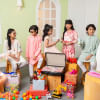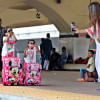Previously looked down upon as a mark of stinginess and perceived as unhygienic by many, the trend of buying second-hand clothing is picking up nicely in the wake of climate change conversations and environmental awareness. Described using enticing terms like "pre-loved" or "pre-worn," thrifting usually involves the purchase of gently used items at reduced rates.
Aside from eco-consciousness, fashion-forward people around the world appreciate this new trend for the uniqueness of the items it offers, self-expression and nostalgia for older or vintage pieces. Unlike fast fashion, which bulk produces similar-looking clothing, thrift shopping allows consumers to cultivate a distinctive style of their own.
While the concept of online thrifting might be relatively new in the country, the practice of exploring flea markets for unique finds has been a traditional practice for decades. While touted to be export-quality stock lots that have minor defects, not all of these items are brand new.
It is important to note, however, that most buyers around the world, including those in Bangladesh, have primarily been drawn to thrifting for its affordability, rather than the environmental benefits and sustainability of recycling clothes. This is because thrift stores often provide high-quality items at a fraction of the price of conventional marketplaces.
Nusrat Jahan Mumu, co-owner of the Facebook page "Dhaka Thrift", has been in the resale business of pre-loved clothing for four years now. "I started Dhaka Thrift as nothing but a business. It was in the thick of the pandemic, and I missed roadside shopping," she says.
Mumu knew that many like her missed thrifting, and she could attract customers through quality control and low prices. However, thanks to the rising awareness of climate change in the country and the influence of social media platforms such as TikTok, Instagram, and YouTube, interest in second-hand shopping has significantly risen. The COVID-19 pandemic heightened this trend further, as individuals became more mindful of their consumption habits.
"Customer awareness has come a long way from when I opened shop in 2021," says Nusrat Jahan Mumu. "When I saw that more and more customers were turning to my page inspired by a will to do something for the climate, I started educating them."
The young entrepreneur says she was quite transparent on her page about the group being one that strictly sold second-hand clothing items. She fought stigmas and hygiene misconceptions around thrifting by taking measures to ensure quality, such as thoroughly cleaning and repairing clothing.
She meticulously curated her collection, ensuring that only items in good condition were offered to customers.
"The demand did not diminish even when people knew these items were pre-worn. That tells you that customers are willing to give this concept a chance if it lets them buy a good quality article of clothing at a reasonable rate," she added.
The owner of yet another Facebook group called "Decluttering Your Wardrobe", Aysha, mentions that when she was using another name for her online business, it was not as popular. However, when she switched to words such as "Recycle Bin" and "Declutter", people flocked to her group in droves.
"I have hundreds of member requests per day, which means people are quite interested in the reselling of their clothes and other items of personal use. It is not an alien concept anymore," Aysha says.
Endorsed by celebrities and influencers, trends like "fashion flipping" — the practice of purchasing second-hand clothing to resell it — and "thrift flipping," which involves upcycling thrifted items into new creations, further cement the sustainability of pre-loved shopping within mainstream fashion.
Thrifting and buying pre-loved clothes can allow shoppers to recycle their own clothing, consequently reducing their carbon footprints. Nusrat, Aysha and entrepreneurs like them have an added advantage — they can make money out of it, providing many people with a source of supplementary income from their sales and platform fees.
Shopping aside, the green mindset adopted in the country has ushered in some practical habits which are both environment and budget-friendly.
Rubab Khan, 32, recommends clothes swapping amongst like-minded friends. Clothes swapping is cost-effective and certainly doesn't compromise your sense of fashion or hygiene. "Buying clothes every week is not something I've practised, even if I could afford it. I am one person; realistically speaking, how many clothes do I ACTUALLY need?"
The communications professional further highlights that our dependency on consumer culture often creates an illusion that everyone can afford everything in the same manner, which is not the case. "Even if you come from the same social class. It's like if you don't jump that 'add to cart' bandwagon, you're somehow missing out on the latest trend."
A variety of Instagram shops curate second-hand culture, such as Vintage Ziana, @aesthrift.bd, Dhaka Vintage, and Thrift Store BD, among others. These platforms allow shoppers to discover incredible pieces at prices ranging from Tk 300 to Tk 700, making them accessible to many. Facebook platforms such as Dhaka Thrift and Decluttering Your Wardrobe have gained popularity by offering unique wares.
With more and more people opening up to the idea of second-hand shopping, this cultural shift encourages a new appreciation for clothing and its stories, moving away, thankfully, from the fast fashion mentality. As we navigate this evolving landscape, it is becoming increasingly clear that thrifting is a lifestyle choice that holds the power to bring positive changes in our society.








Comments